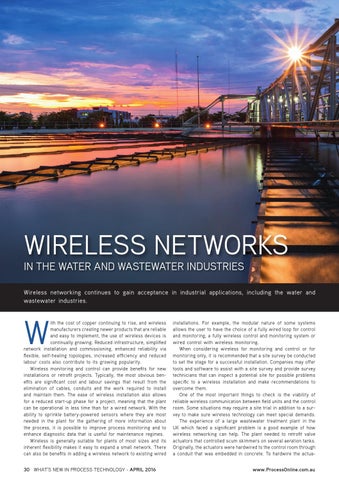WIRELESS NETWORKS IN THE WATER AND WASTEWATER INDUSTRIES
Wireless networking continues to gain acceptance in industrial applications, including the water and wastewater industries.
W
ith the cost of copper continuing to rise, and wireless manufacturers creating newer products that are reliable and easy to implement, the use of wireless devices is continually growing. Reduced infrastructure, simplified network installation and commissioning, enhanced reliability via flexible, self-healing topologies, increased efficiency and reduced labour costs also contribute to its growing popularity. Wireless monitoring and control can provide benefits for new installations or retrofit projects. Typically, the most obvious benefits are significant cost and labour savings that result from the elimination of cables, conduits and the work required to install and maintain them. The ease of wireless installation also allows for a reduced start-up phase for a project, meaning that the plant can be operational in less time than for a wired network. With the ability to sprinkle battery-powered sensors where they are most needed in the plant for the gathering of more information about the process, it is possible to improve process monitoring and to enhance diagnostic data that is useful for maintenance regimes. Wireless is generally suitable for plants of most sizes and its inherent flexibility makes it easy to expand a small network. There can also be benefits in adding a wireless network to existing wired
30 WHAT'S NEW IN PROCESS TECHNOLOGY - APRIL 2016
installations. For example, the modular nature of some systems allows the user to have the choice of a fully wired loop for control and monitoring, a fully wireless control and monitoring system or wired control with wireless monitoring. When considering wireless for monitoring and control or for monitoring only, it is recommended that a site survey be conducted to set the stage for a successful installation. Companies may offer tools and software to assist with a site survey and provide survey technicians that can inspect a potential site for possible problems specific to a wireless installation and make recommendations to overcome them. One of the most important things to check is the viability of reliable wireless communication between field units and the control room. Some situations may require a site trial in addition to a survey to make sure wireless technology can meet special demands. The experience of a large wastewater treatment plant in the UK which faced a significant problem is a good example of how wireless networking can help. The plant needed to retrofit valve actuators that controlled scum skimmers on several aeration tanks. Originally, the actuators were hardwired to the control room through a conduit that was embedded in concrete. To hardwire the actua-
www.ProcessOnline.com.au
